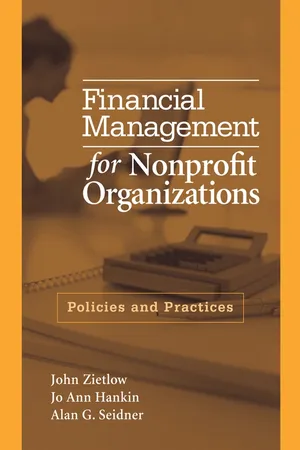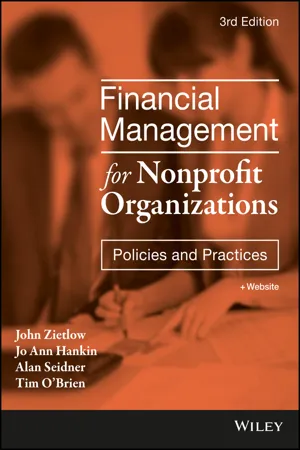Business
Managing Debt
Managing debt in business involves keeping track of all debts owed and making timely payments to avoid penalties and interest charges. It also involves creating a debt repayment plan to reduce debt over time and improve the company's financial health. Effective debt management can help businesses maintain good credit scores and access financing when needed.
Written by Perlego with AI-assistance
Related key terms
3 Key excerpts on "Managing Debt"
- eBook - ePub
Financial Management for Nonprofit Organizations
Policies and Practices
- John Zietlow, Jo Ann Hankin, Alan Seidner(Authors)
- 2011(Publication Date)
- Wiley(Publisher)
Financial risk is the possibility that your organization will not be able to meet its fixed, financing-related obligations. We saw examples of this in our chapter-opening vignettes. One cannot “lay off” interest or principal payments as one lays off workers or cuts back on other discretionary expenses. Arranged borrowing, whether a bank credit line or bonds issued to investors, represents a contractual agreement that must be taken very seriously. Your organization and its stakeholders stand to lose if you are not prudent in your use of debt.(a) BALANCE SHEET MANAGEMENT: BENEFITS AND STEPS.
What constitutes a well-managed balance sheet? According to Wareham and Majka, a well-managed balance sheet:- Supports the organization’s strategic plan within an appropriate credit context
- Provides the most flexibility, given market expectations and legal considerations
- Reflects the optimal capital framework, given the organization’s needs, capabilities, and risk profile
- Provides the lowest overall cost for the risk of the asset and liability portfolios
- Allows for future financing needs4
- 1. Analyze your cash levels and debt capacity—no surprise here. We have emphasized that the achieving and maintaining your target liquidity level is your numberone financial objective.
- 2. Assess your capital needs.
- 3. Match capital needs with capital sources.
- 4. Consider alternative capital sources.
- 5. Mitigate risks.
- 6. Monitor the balance sheet on an ongoing basis.5
Step 1, analyzing your cash levels and debt capacity, involves determining days’ cash on hand from all unrestricted sources (cash plus short-term investments plus unrestricted long-term investments, divided by [(total expenses – depreciation expense)/365], the current ratio, the ability to cover debt service (both interest payments and principal repayments), and days’ sales outstanding (if your organization has any credit sales). You may wish to refer to Chapter 7 - Stephan Leimberg, Carolynn Tomin, William B. Reeve(Authors)
- 2023(Publication Date)
- The National Underwriter Company(Publisher)
Credit management involves analyzing the various sources of borrowing available to a client. These potential sources of funds can have advantages or disadvantages as they relate to financial goals. Credit management also involves planning and developing strategies to improve and maximize credit scores. Once funds have been borrowed, then debt management begins. Using previously discussed financial planning tools such as budgeting and cash flow statements, debt management relies on those strategies to minimize both the cost of debt and the amount of debt employed. The eventual goal of debt management is to be debt free. Advisers and their clients are faced with a host of consumer finance and personal financial-planning issues all the time, especially with respect to credit arrangements such as credit cards, home financing or refinancing, home-equity lines of credit, or automobile financing and leasing.This chapter discusses what characteristics creditors look for when granting credit, debt ratios and their use as guidelines to reasonable and manageable debt limits, how to deal with debt problems and over-borrowing, credit reports, the FICO credit score, how to improve one’s credit, how to deal with identity theft, and the major consumer protection laws.14.1a Credit Management
People get credit by promising to pay in the future for something they receive in the present. At times, credit is necessary and other times, it is a convenience. Most people can only afford to purchase a home by using credit. Other uses of credit include convenience purchases such as a meal on their credit card, or pay for an appliance on the installment plan. With credit, people can enjoy their purchases while they are still paying for them—or they can make a purchase when they are lacking the available cash.However, there are strings attached to the use of credit as well. Using credit costs money and when borrowing occurs there is an obligation to the borrower to repay the loan. Failure to do so can lead to serious financial consequences ranging from impaired creditworthiness to losses of assets, including cars and homes, and may cause a significant reduction in one’s standard of living. Consequently, people should manage their use of debt judiciously, diligently safeguard their creditworthiness, and strive to keep their debt balances and debt payments at reasonable and manageable levels.- eBook - ePub
Financial Management for Nonprofit Organizations
Policies and Practices
- John Zietlow, Jo Ann Hankin, Alan Seidner, Tim O'Brien(Authors)
- 2018(Publication Date)
- Wiley(Publisher)
Seasonality of revenues can have a tremendous impact on your organization's short-term borrowing requirements. By looking at historic seasonal revenue patterns, your financial team can obtain part of the picture needed to plan borrowing strategy. Additionally, you must monitor and measure the lag time between the provision of services and the collection of revenues (whether from donations, grants, or fees charged) as well as predict the amount likely to be collected. Your collection pace on receivables, when slowing, may dictate that the institution arrange a larger credit line to see it through the lean months. By analyzing your organization's cash flow, the financial manager can anticipate this situation and plan accordingly.10.6 STEPS TO SUCCESSFUL BORROWING
Management will be ready to approach potential financing sources after determining strategic objectives and developing a forecast that indicates the amount of money needed, when it must be borrowed, and when it can be repaid. If the need is within the next 12–18 months, the cash forecast will be of paramount importance (see Chapter 8 ). If the need stretches out from 2 to 30 years, the projected financial statements will be required (see Chapter 9 ). Before any financial source is approached, however, financial managers must understand:- Debt and what borrowing involves for the organization
- The loan approval process
- The various short-term borrowing alternatives
- The suitability of financing sources versus strategic objectives
- The preparation and presentation of a loan request
(a) UNDERSTANDING DEBT. Debt is a way of life for most consumers and business organizations. It is interesting to note that borrowing and investing are two sides of the same coin. “Capital” can be defined as the resources that an organization needs to attain a financial objective. There are two broad categories of capital: equity and debt. Equity is money belonging to the organization, and debt is money belonging to another person or organization. Borrowed funds carry the borrower's obligation to repay the debt, and lenders furnish money for the sole purpose of earning more money. Our references to the characteristics of equity, or net assets, are to provide a basis for comparison.(i) Risk-Reward Trade-Offs
Index pages curate the most relevant extracts from our library of academic textbooks. They’ve been created using an in-house natural language model (NLM), each adding context and meaning to key research topics.


